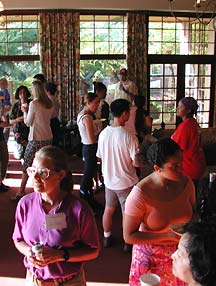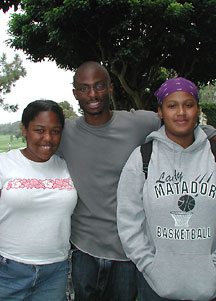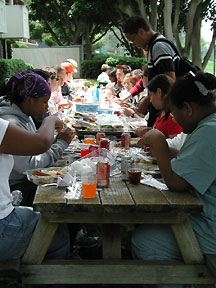TSRI Internship Program Offers "Way Cool" Summer
Jobs
By Jennifer O'Sullivan
Do you remember your first summer job? What about your first
full-time job? Put those two together and you may be faced
with a previously repressed memory. Or, if you are among a
lucky few—and many of The Scripps Research Institute's
(TSRI) young summer interns may later fall into this category—your
first work experiences have a strong connection to what you're
doing today.
In the Summer Research Internship Program at TSRI, students,
teachers, and undergraduates participate in an eight-week
program emphasizing the scientific process, bench experience,
data analysis, experimental design, and interaction with laboratory
personnel. For the high school students, the experience follows
the Spring Semester Enrichment Tutorials at TSRI.
Interns are placed after interviewing with several labs—in
itself a valuable experience. For many, like Mt. Miguel High
School student Samantha Anderson, this is the first time they've
ever been on a job interview.
"I wasn't nervous, though," Samantha tells me, referring
to her interview with Associate Professor Cindy Ehlers and
members of her Neuropharmacology lab. "They described the
work they do and asked me about my family and what I did at
school. It was cool."
After completing interviews, the TSRI summer intern class
of 2001, consisting of 22 high school students, four teachers,
and six undergraduates, began working at TSRI on Monday, June
25 and will continue five days a week, 8:30 AM to 5 PM, for
eight weeks. While the schedule is an adjustment for the high
schoolers, and certainly stands in stark contrast to friends
who are hitting the beach on a daily basis, these are teenagers
with curiosity and drive.
Samantha is now working in the Ehlers lab along with fellow
intern Loicia Ware under the supervision of Antonio Sweeney,
an alumnus of the TSRI High School Summer Internship Program
and a fourth-year microbiology student at the University of
California, San Diego (UCSD). Tony interned during the summer
of 1997 and later took first place in the category of medicine
and health at the Greater San Diego Science and Engineering
Fair with the project he completed in the Ehlers lab. He has
been working there ever since as a research assistant and
summer intern supervisor.
"I still feel connected because every summer I meet a new
student. My first student is now at the University of California,
Los Angeles (UCLA) and my second and third are at UCSD," he
tells me.
Tony was recommended for the internship program four years
ago by Larry Nordell, who teaches basic chemistry and advanced
topics in biology and chemistry at Mt. Miguel High School.
Mr. Nordell, as the interns call him, and others like him
are a vital part of the program's continued success.
"If it wasn't for Mr. Nordell I wouldn't be here," says Lali
Villalobos, who is interning in the lab of Associate Professor
Jeffrey Harper in the Department of Cell Biology. Nordell
encouraged Lali and other students to take a biotechnology
class offered at Mt. Miguel last year, where they gained experience
working with pipettes and making media, and also learned about
the TSRI program.
Now Lali is tackling all she can in plant biology with Dr.
Harper, along with her mentor, Research Technician Shawn Romanowsky.
"We're studying a plant called the Arabidopsis and
looking for calcium pump knockouts throughout the DNA," Lali
tells me while thumbing through a notebook filled with notes,
sketches and photocopied sections of journal papers she has
looked up. Lali explains that the "knockouts" are pumps that
expire, allowing for the isolation of functioning pumps to
determine which are necessary for the plant's survival. "What
I've done," she states with pride, "is found some. I found
two out of three knockouts."
In addition to their daily work, summer interns also come
together for specially designed seminars, lunchtime gatherings,
and a field trip to another scientific institution or biotech
company. Students are expected to keep a weekly journal, make
an oral presentation and submit a written report at the conclusion
of the program. Parents, high school science department chairs,
and TSRI mentors are invited to attend the presentations and
a luncheon on the last day.
I ask Lali if she thinks she'll be on the other end of all
this someday, running her own lab and mentoring a student.
She says she's not sure yet if she'll major in biochemistry
or medicine, but knows her studies will involve science somehow.
"Science is what I will do," she states resolutely, then
cracks a sassy smile. "It's my thing."
This is certainly something to smile about, because providing
students who play an active role in their own education with
the opportunity to find and pursue their "thing" is precisely
the goal of TSRI's High School Summer Internship Program.

|

TSRI graduate students and faculty mingle with new summer
interns and parents at a welcome reception held at the TSRI
Conference Center. Photo by Jason S. Bardi.

Former TSRI intern Tony Sweeney (center) likes working with
Samantha Anderson (right) and Loicia Ware (left) because it
keeps him connected to the internship program. Photo by Kevin
Fung.

Working at TSRI makes summer interns hungry. Photo by Kevin
Fung.
|

